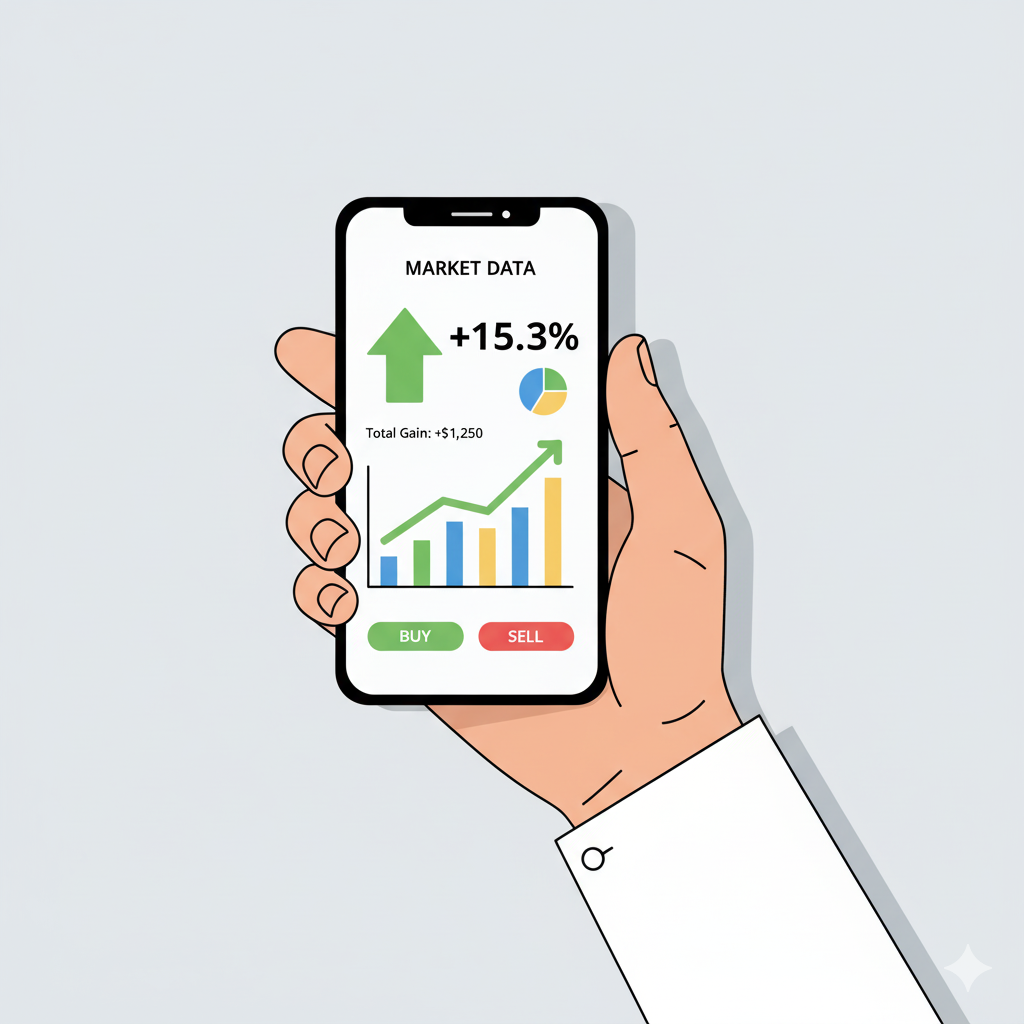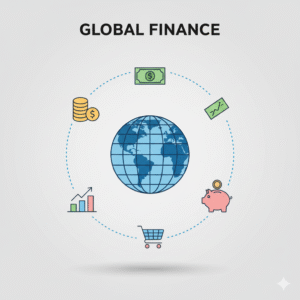How Interest Rates Affect Stock Prices

You hear it on the news constantly. A commentator says, “The Federal Reserve is expected to change interest rates,” and suddenly, the stock market reacts—sometimes violently. For many, the connection between a seemingly obscure economic lever and the value of their 401(k) can feel like a mystery.
But what if you could understand this relationship? What if you knew why the market gets jittery before a Fed meeting and how to interpret what it means for your investments?
Understanding the link between interest rates and stock prices is one of the most fundamental skills a successful investor can develop. It’s not just for Wall Street analysts; it’s for anyone who wants to make smarter decisions with their money. This comprehensive guide will break down this crucial connection in simple, easy-to-understand terms. We’ll explore the core mechanics, look at how different industries are affected, and provide actionable strategies to navigate a changing rate environment.
First, The Basics: What Exactly Are “Interest Rates”?

Before we dive into the deep end, let’s establish a clear foundation. When people talk about “interest rates” in the context of the stock market, they are almost always referring to the federal funds rate.
This is the interest rate at which commercial banks lend their excess reserves to each other overnight. You don’t deal with this rate directly, but it’s the bedrock of the entire financial system. The Federal Reserve (often called “the Fed”), America’s central bank, sets a target for this rate.
Think of the federal funds rate as the wholesale cost of money. When this rate goes up or down, it creates a ripple effect, influencing every other interest rate you do encounter:
- Mortgage rates for buying a home
- Auto loan rates for a new car
- The Annual Percentage Rate (APR) on your credit cards
- The interest rate on a business loan
So, when the Fed “raises rates,” it’s making the foundational cost of borrowing money more expensive for everyone, from the biggest corporations to the average consumer. When it “lowers rates,” it’s making borrowing cheaper. This single action has profound consequences for the economy and, by extension, the stock market.
The Core Relationship: Why Stock Prices and Interest Rates Often Move Like a Seesaw
The general rule of thumb is that interest rates and stock prices have an inverse relationship.
- When interest rates rise, stock prices tend to fall.
- When interest rates fall, stock prices tend to rise.
Imagine a seesaw. On one end, you have interest rates. On the other, you have stock prices. When one side goes up, the other tends to go down. But why does this happen? It’s not magic; it’s driven by four powerful economic forces.
1. The Rising Cost of Doing Business
Corporations are the engines of the stock market, and like any engine, they often need fuel—in this case, capital. Companies borrow money for countless reasons: to build new factories, hire more employees, fund research and development, or acquire competitors.
When interest rates rise, the cost of borrowing this money increases. A loan that might have had a 3% interest rate last year could now have a 6% rate. This has a direct impact on a company’s bottom line. Higher interest payments mean less profit.
Lower Profits = Lower Stock Valuations.
Wall Street analysts are constantly building models to predict a company’s future earnings. When they adjust these models to account for higher interest expenses, their profit forecasts go down. If a company is expected to be less profitable in the future, its stock becomes less attractive to investors today, and its price falls.
2. The “Discounting” Effect: Why Future Money Is Worth Less Today
This is a slightly more advanced concept, but it’s crucial for understanding stock valuation. The theoretical value of a stock is the sum of all its expected future profits, “discounted” back to their value in today’s dollars.
Think of it this way: would you rather have $100 today or a promise of $100 a year from now? You’d take it today, of course. Money today is worth more than money in the future because of its potential to earn interest.
The interest rate is used as a key component of the “discount rate.” When interest rates are high, the discount rate is also high. This means a company’s future earnings are worth significantly less in today’s dollars.
Example:
- Low-Rate Scenario (2% discount rate): A company’s projected $10 million in profit five years from now might be valued at $9.06 million today.
- High-Rate Scenario (6% discount rate): That same $10 million in profit is now only valued at $7.47 million today.
It’s the same future profit, but the higher interest rate makes it less valuable right now. As this calculation is applied across all of a company’s expected future earnings, its overall stock valuation shrinks, even if its business operations haven’t changed at all.
3. The Great Rivalry: Stocks vs. Bonds in a High-Rate World
Investors are always looking for the best possible return on their money for a given level of risk. When interest rates are low, “safe” investments like government bonds, CDs, or high-yield savings accounts offer very poor returns. For example, if a 10-year Treasury bond is only paying 1.5%, investors might feel compelled to take on the higher risk of the stock market to get a better return. This pushes stock prices up.
However, when the Fed raises interest rates, that dynamic flips.
Suddenly, those “boring” bonds start looking much more attractive. If you can get a guaranteed 5% return from a U.S. government bond (considered virtually risk-free), the proposition of risking your money in the stock market for a potential, but not guaranteed, 8% return becomes less appealing.
This triggers a flow of money known as the “great rotation.” Capital begins to move out of riskier assets (like stocks) and into safer, higher-yielding fixed-income assets (like bonds). This selling pressure on stocks causes their prices to decline.
4. How Your Wallet’s Health Influences the Stock Market
The ripple effect of interest rates doesn’t just hit Wall Street; it hits Main Street. When rates go up, your mortgage payment increases, your car loan becomes more expensive, and the interest on your credit card balance skyrockets.
This leaves less disposable income in your pocket. With less money to spend, consumers tend to cut back on discretionary purchases—that new TV, a family vacation, or dining out.
This reduction in consumer spending directly hurts the revenues of a huge swath of companies. If people are buying fewer cars, Ford’s profits suffer. If people are eating out less, Starbucks and McDonald’s see their sales decline. Since consumer spending is the largest driver of the U.S. economy, a slowdown here has a massive negative impact on corporate earnings and, consequently, stock prices.
Not All Stocks Are Created Equal: Sector-Specific Impacts of Rate Changes

While rising rates tend to pull the entire market down, they don’t affect all companies equally. Some sectors are far more sensitive to interest rate changes than others.
Highly Sensitive Sectors (Often Hurt by Rising Rates)
- Growth and Technology Stocks: These companies (think software, biotech, and innovative tech) often have very little in current profits. Their stock valuations are based almost entirely on the promise of huge profits far in the future. As we learned from the “discounting effect,” those distant future earnings get hit the hardest when interest rates rise. This is why the tech-heavy NASDAQ index is often more volatile during periods of rate changes.
- Capital-Intensive Industries (Utilities and Real Estate): Companies in these sectors need to borrow massive amounts of money to build power plants, maintain infrastructure, or develop properties. Higher rates directly increase their operating costs and squeeze profit margins. Additionally, dividend-paying stocks like utilities are often seen as “bond proxies.” When bond yields rise, these stocks become less attractive by comparison, causing their prices to fall.
- Consumer Discretionary: These are companies that sell non-essential goods and services (automakers, luxury brands, travel companies). As discussed, when higher rates curb consumer spending, these are often the first companies to feel the pinch.
Less Sensitive or Potentially Benefitting Sectors (Can Withstand or Gain from Rising Rates)
- Financials (Banks): This is the classic exception to the rule. Banks can actually benefit from rising interest rates. Their business model involves borrowing money at short-term rates (like paying interest on your savings account) and lending it out at long-term rates (like a mortgage). When rates rise, the spread between what they pay and what they earn—their net interest margin—often widens, leading to higher profits.
- Consumer Staples: These companies sell essential goods that people buy regardless of the economic climate (think toothpaste, toilet paper, and basic food items from companies like Procter & Gamble or Coca-Cola). While not immune, their sales are far more resilient to a slowdown in consumer spending.
- Energy and Materials: The performance of these sectors is often more closely tied to commodity prices and global supply and demand than to domestic interest rates. A global oil shortage, for example, can cause energy stocks to soar even if the Fed is raising rates.
What Should Investors Do When Interest Rates Change? A Strategic Guide
Watching the market react to Fed news can be nerve-wracking. The key is to have a plan and avoid making emotional decisions.
- Don’t Panic: The single worst thing an investor can do is sell everything in a panic when rates start to rise. The market often overreacts in the short term. Remember that investing is a long-term game.
- Focus on Quality and Profitability: In a rising rate environment, companies with strong balance sheets, low debt, and consistent, robust cash flow become far more attractive. Speculative, unprofitable companies that rely on cheap debt to survive are the most vulnerable.
- Review Your Diversification: Is your portfolio heavily weighted towards rate-sensitive sectors like technology? It might be a good time to ensure you have adequate exposure to less-sensitive sectors like healthcare, consumer staples, or even financials, which can provide balance.
- Consider Value Over Growth: As growth stocks get punished by the discounting effect, “value” stocks—established companies trading at reasonable prices relative to their earnings—often perform better.
- Stay the Course with Your Long-Term Plan: For most people investing for retirement in a 401(k) or IRA, the best strategy is to continue making regular contributions (dollar-cost averaging). You’ll be buying shares at lower prices during downturns, which can significantly boost your returns over the long run.
The Inflation Connection: The Real Reason the Fed Acts

We can’t discuss interest rates without talking about inflation. Inflation is the rate at which the general level of prices for goods and services is rising, and subsequently, purchasing power is falling.
The Federal Reserve has a dual mandate: to promote maximum employment and to maintain stable prices. High inflation is the enemy of stable prices. It erodes the value of savings and can destabilize the economy.
The Fed’s primary tool for fighting inflation is raising interest rates.
By making money more expensive to borrow, the Fed aims to cool down the economy. This reduces demand from both businesses and consumers, which in turn helps to bring prices back under control. So, when you see high inflation numbers in the news, you can almost always expect the Fed to be considering—or already executing—interest rate hikes. Conversely, if the economy is weak and inflation is very low, the Fed will lower rates to encourage borrowing and stimulate economic activity.
Seeing the Bigger Picture
The relationship between interest rates and the stock market is a fundamental dance of economics. Higher rates make borrowing more expensive for companies and consumers, increase the appeal of safer investments like bonds, and reduce the present value of future corporate profits. The cumulative effect is typically a headwind for the stock market.
However, it’s crucial to remember that interest rates are just one piece of a much larger puzzle. The overall health of the economy, corporate innovation, geopolitical events, and investor sentiment all play significant roles in determining market direction.
By understanding how this key relationship works, you move from being a passive observer to an informed investor. You can better anticipate market reactions, position your portfolio more thoughtfully, and maintain the discipline needed to achieve your long-term financial goals, no matter which way the interest rate seesaw is tilting.







